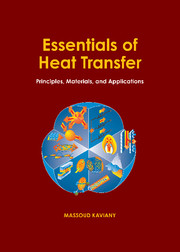Book contents
- Frontmatter
- Contents
- Preface
- Acknowledgments
- Guide to Instructors and Students
- 1 Introduction and Preliminaries
- 2 Energy Equation
- 3 Conduction
- 4 Radiation
- 5 Convection: Unbounded Fluid Streams
- 6 Convection: Semi-Bounded Fluid Streams
- 7 Convection: Bounded Fluid Streams
- 8 Heat Transfer in Thermal Systems
- Nomenclature
- Glossary
- Answers to Problems
- Appendix A Some Thermodynamic Relations
- Appendix B Derivation of Differential-Volume Energy Equation
- Appendix C Tables of Thermochemical and Thermophysical Properties
- Subject Index
6 - Convection: Semi-Bounded Fluid Streams
Published online by Cambridge University Press: 05 June 2012
- Frontmatter
- Contents
- Preface
- Acknowledgments
- Guide to Instructors and Students
- 1 Introduction and Preliminaries
- 2 Energy Equation
- 3 Conduction
- 4 Radiation
- 5 Convection: Unbounded Fluid Streams
- 6 Convection: Semi-Bounded Fluid Streams
- 7 Convection: Bounded Fluid Streams
- 8 Heat Transfer in Thermal Systems
- Nomenclature
- Glossary
- Answers to Problems
- Appendix A Some Thermodynamic Relations
- Appendix B Derivation of Differential-Volume Energy Equation
- Appendix C Tables of Thermochemical and Thermophysical Properties
- Subject Index
Summary
The surface-convection heat transfer coefficient can be represented in a universal, dimensionless form, similar to the surface friction representation in hydraulics.
– W. NusseltA semi-bounded fluid stream in thermal nonequilibrium with its bounding solid surface exchanges heat by surface convection qku and this alters its temperature (and qk and qu) only in a region adjacent to the bounding surface (i.e., the farfield temperature is unchanged). In this chapter we consider a steady, semi-bounded fluid stream flowing over a solid surface (e.g., flow over a plate or a sphere) at a far-field velocity uf,∞ with the solid Ts and the far-field Tf,∞ fluid having different temperatures. We initially focus on the fluid and its motion and heat transfer adjacent to the surface (because of this focus, the chapter title, semi-bounded fluid streams, is used. Also as will be shown, there are some similarities with the transient conduction in semi-infinite solid). Later we include the heat transfer with any bounding solid (i.e., the substrate). This is also called external flow heat transfer. In Chapter 7 we will consider steady, bounded fluid streams (e.g., flow in a tube). This is also called internal flow. We are interested in the parameters and conditions influencing the surface-convection heat flux qku and its spatial variation. These parameters and conditions include the direction of the fluid flow with respect to the bounding surface (e.g., fluid flow parallel to the surface, perpendicular to the surface, or oblique), flow structure, fluid properties, liquid-gas phase change, and solid-surface conditions.
Information
- Type
- Chapter
- Information
- Essentials of Heat TransferPrinciples, Materials, and Applications, pp. 426 - 569Publisher: Cambridge University PressPrint publication year: 2011
